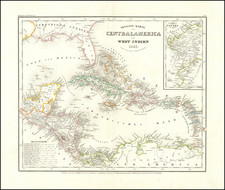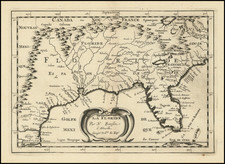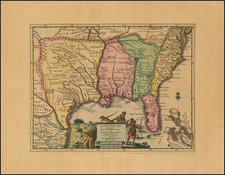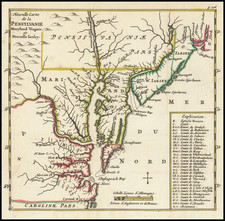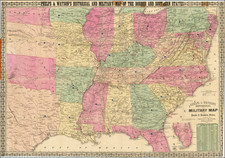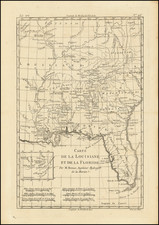The Most Comprehensive Battle Plan of the Siege Charleston
Fine old color example of Des Barres' rare battle plan of the Siege of Charleston, published by Joseph Frederick Wallet Des Barres in London, in 1781.
Des Barres map is of special importance because of its complete depiction of the theater of war around Charleston, showing the positions, fortifications and troop movements of both the Continental Army and the British. Des Barres map is one of only two contemporary maps to show the British advances by land from the north and the southwest--all other contemporary maps focusing on the conflict around the town of Charleston, Charleston Harbor, Sullivan Island and the lower Ashley River and Cowper River.
The siege and capture of Charleston is depicted by 3 maps prepared by De Barres. Two of Des Barres maps are primarily sea charts, focused on the naval engagement. By contrast, present map shows a much broader theater, showing the British troop movements by land in the weeks prior to the final battle, thereby capturing the entirety of the siege from start to finish. As noted below this map emphasizes the broader theater, both to the southwest and the north, including:
- Landing of a diversionary British force at Edisto Island in early February 1780, which then proceeded northward towards Charleston over the next month through Johns Island to James Island, with a number of positions shown. The map also extends much further to the north, tracking the movements of the British troops southward from Savannah, beginning at the point where the British Troops under Lord Cornwallis crossed the Ashley River, 14 miles north of Charleston on March 29, 1780.
- Rebouts and positions of the British Troops on James Island and the Stono River, on the southwest side of James Island, used to protect the incoming troop transports.
- The forces marching from Savannah southward to Charleston, beginning about 14 miles north of Charleston, at the point where the forces under Lord Cornwallis crossed the Ashley River and continuing southward down both sides of the River and across the Charleston Neck toward the city.
This present example of the map is the second state, which is significantly improved. Whereas the first state was published before news of Clinton's surrender, this second state depicts the complete details of the siege from the landing of the King's Troops at Edisto to the final British surrender. The reference key is completely re-engraved, to provide a far more detailed account of the Siege.
The coast lines and banks of the rivers and inlets are shown in relief with a narrow band of shading, whereas the first state showed only a tentative outline. Numerous additional military and naval positions are inserted, as are roads and soundings.
The Siege of Charleston
The 1780 siege of Charleston was a decisive success for the British, as part of a strategy to shift the focus of the American Revolutionary War to the South, with an eye toward encouraging Southern Loyalist Tories to rise up against the Colonial Rebels. The seizure of Charleston provided an important base of operations for the British and dealt the Americans forces a significant blow.
Following the British success at Savannah, the Americans knew that Charleston was the next likely British target. Washington warned Charleston's commanding officer, Major General Benjamin Lincoln, of the probable attack, while informing Lincoln that the main American forces could not offer meaningful support. Lincoln had arrived in Charleston in late 1779, finding its fortifications to be weak and incomplete at best, spurring an urgent effort to strengthen its defenses.
The British forces, led by Lieutenant General Sir Henry Clinton, sailed from New York in later December 1779, arriving at the Savannah River in late January 1780, where it quickly attacked and took the city. Clinton next moved on Charleston from the south and the west, avoiding the more heavily fortified Fort Moultrie. The Americans engaged the British, but without much hope of success. Washington authorized Lincoln to abandon the city, but local leaders convinced Lincoln to stay.
By end of March, 1780, the British forces under Cornwallis crossed he Ashley River and marched south to Charleston and by April 1, 1780 British forces began digging siege lines across the neck of the Charleston peninsula. Clinton undertook a methodical siege, with the idea of keeping the harbor intact, earning the loyalty of the civilian population and facilitating British use as a base of operations.
Joseph Frederick Wallet Des Barres
Joseph Frederick Wallet Des Barres was born in Switzerland, where his Huguenot ancestors had fled following the repeal of the Edict of Nantes. He studied under the great mathematician Daniel Bernoulli at the University of Basel, before immigrating to Britain where he trained at the Royal Military College, Woolwich. Upon the outbreak of hostilities with France in 1756, he joined the British Royal American Regiment as a military engineer. He came to the attention of General James Wolfe, who appointed him to join his personal detail. During this period he also worked with the legendary future explorer James Cook on a monumental chart of the St. Lawrence River.
Upon the conclusion of the Seven Years War, Britain's empire in North America was greatly expanded, and this required the creation of a master atlas featuring new and accurate sea charts for use by the Royal Navy. Des Barres was enlisted to survey the coastlines of Nova Scotia, Newfoundland, and the Gulf of St. Lawrence. With these extremely accurate surveys in hand, Des Barres returned to London in 1774, where the Royal Navy charged him with the Herculean task of producing the atlas. He was gradually forwarded the manuscripts of numerous advanced surveys conducted by British cartographers in the American Colonies, Jamaica and Cuba, of which the present map is based on the work of Samuel Holland, conducted in the 1760s. The result was The Atlantic Neptune, which became the most celebrated sea atlas of its era, containing the first systematic survey of the east coast of North America. Des Barres's synergy of great empirical accuracy with the peerless artistic virtue of his aquatint views, created a work that "has been described as the most splendid collection of charts, plates and views ever published" (National Maritime Museum Catalogue).
The Neptune eventually consisted of four volumes and Des Barres's dedication to the project was so strong that often at his own expense he continually updated and added new charts and views to various editions up until 1784, producing over 250 charts and views, many appearing in several variations. All of these charts were immensely detailed, featuring both hydrographical and topographical information, such that in many cases they remained the most authoritative maps of the regions covered for several decades. Following the completion of The Neptune, Des Barres returned to Canada, where he remained for a further forty years, becoming a senior political figure and a wealthy land owner, living to the advanced age of 103.
Rarity
The map is rare on the market. We note 2 examples offered at auction since 2000 and no appearances in dealer catalogs listed by AMPR in the past 30 years.
Joseph Frederick Wallet Des Barres (1721-1824) was born in either Paris or Basel, Switzerland, to a Hugueont family. He studied under the great mathematician Daniel Bernoulli at the University of Basel before immigrating to Britain, where he trained at the Royal Military College, Woolwich.
Upon the outbreak of hostilities with France in 1756, he joined the British Royal American Regiment as a military engineer. He came to the attention of General James Wolfe, who was impressed with his charting ability. During this period, he also worked with the legendary future explorer, James Cook, on a monumental chart of the St. Lawrence River.
Des Barres is best known for the Atlantic Neptune, was a remarkable, multi-volume set of sea charts and coastal views prepared from recent surveys, some of which were overseen by Des Barres in Nova Scotia after the Seven Years’ War. The maps, charts, and views were prepared under the supervision of Des Barres and employed as many as twenty engravers and assistants. They were produced over the course of a decade, from 1774 to 1784, in time to be used by the Royal Navy in the American Revolution.
After the Revolution, Loyalists were resettled throughout Canada. As part of this process, a new colony was created by separating Cape Breton from Nova Scotia. Des Barres, who already owned extensive lands in the Maritimes, served as lieutenant governor of Cape Breton Island from 1784 to 1787. He later served as governor of Prince Edward Island from 1804-1812.
Des Barres lived an exceptionally long life, even by today's standards, finally dying at age 102. Des Barres' funeral was held at St. George's Round Church in 1824 and he is buried in Halifax.









